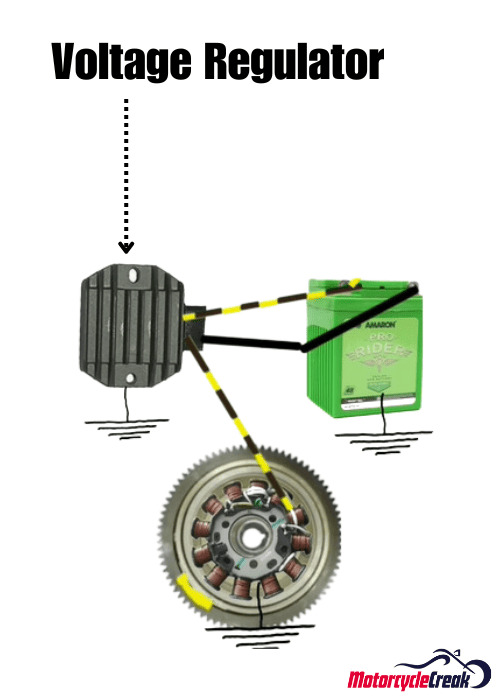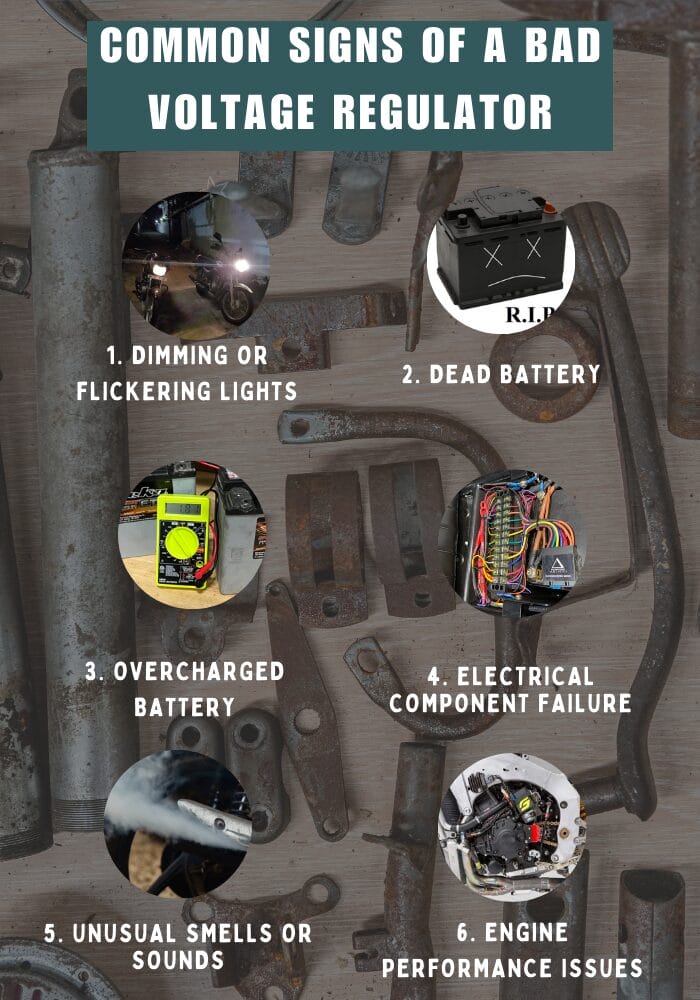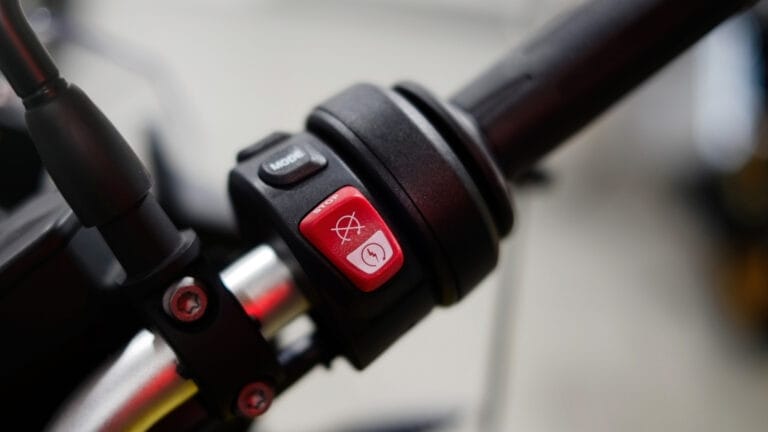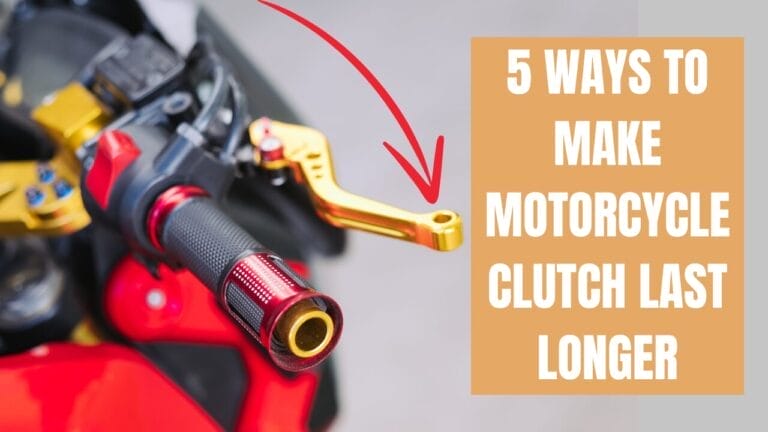signs of a bad voltage regulator motorcycle
Ever wondered why your motorcycle’s lights seem to have their own dimming schedule or why your battery dies at the most inconvenient times? The answer could lie in a bad voltage regulator. This crucial component keeps the electrical system humming and your battery charged just right, preventing overcharging and undercharging issues.
In this article, we’ll walk you through the warning signs of a failing voltage regulator and equip you with the know-how to address the issue before it leaves you stranded.
Ready to keep your ride in prime condition?
Let’s get rolling; it’s going to be an enlightening journey!
What is a Voltage Regulator?
A voltage regulator is like a gatekeeper; It keeps the voltage levels in check, ensuring the right amount of electrical power flows to your bike’s battery and electrical components.

Here’s how it works
When your motorcycle’s engine is running, the alternator generates electricity. This electricity can vary in voltage, which is where the voltage regulator comes in. It adjusts the output to ensure a safe voltage reaches the battery and other electrical parts. Without it, you’d be dealing with a rollercoaster of electrical issues, from dead batteries to blown bulbs, malfunctioning electronics, etc. The voltage regulator keeps everything balanced and running smoothly so you can enjoy a hassle-free ride.
Importance of a Voltage Regulator in Motorcycles
A voltage regulator is a small component that balances your electrical system. It ensures that your battery and electronics receive just the right amount of power, which is crucial for your bike’s overall performance and reliability.
If your battery is overcharging, it can be particularly harmful. It will overheat, swell, and eventually leak, leading to a need for costly replacements. On the flip side, undercharging leaves you with a weak battery that struggles to hold a charge, often leaving you stranded when you least expect it.
Beyond battery damage, a bad voltage regulator can cause your lights to flicker or dim, making night rides hazardous. It can also lead to electrical component failures, blowing a fuse, and damaging sensitive electronics. Keeping your voltage regulator in top shape is essential to avoid these unexpected breakdowns and expensive repairs.
Common Signs of a Bad Voltage Regulator
Knowing the signs of a bad voltage regulator can save you from unexpected breakdowns and costly repairs. Here are the key symptoms to watch out for:

1. Dimming or Flickering Lights
The voltage regulator provides a steady stream of power. When it fails, the lights receive inconsistent power, causing them to dim or flicker unpredictably. So, if your motorcycle’s headlights and dashboard lights are dimming or flickering, it could signal voltage irregularities.
2. Dead Battery
When the regulator isn’t properly charging the battery, it will eventually lose its charge. In that case, you might notice that your motorcycle struggles to start or that the battery drains quickly, even after a full charge. So, a dead battery, especially if it’s new, can indicate a faulty voltage regulator.
3. Overcharged Battery
On the flip side of a dead battery, sometimes your battery can overcharge due to a bad voltage regulator. This occurs when the voltage regulator fails to limit the charging voltage, pumping too much power into the battery. Signs of an overcharged battery include a swollen battery casing, leaking battery acid, or a scorching battery.
4. Electrical Component Failure
A bad voltage regulator cannot maintain a consistent battery voltage, causing power surges or drops that damage sensitive components. It can cause various voltage regulator problem and electrical components to fail. This includes blown fuses, malfunctioning gauges, and erratic behavior from other electronic systems.
5. Unusual Smells or Sounds
A malfunctioning voltage regulator can cause overheating in the electrical system, leading to a burning smell. So, a burning smell or strange sounds can be a red flag. Additionally, you might hear buzzing or whining noises from the regulator itself, indicating it’s struggling to operate correctly.
6. Engine Performance Issues
When the voltage regulator fails, it disrupts the electrical supply to the ignition system, affecting the engine’s operation. You might experience misfires, poor acceleration, or engine stalling due to this issue.
How To Diagnose a Bad Voltage Regulator
Finding out if your voltage regulator is on the fritz isn’t rocket science. It requires a keen eye and a few simple tools. Here’s how to pinpoint the problem like a pro:
1. Visual Inspection
Start by visually inspecting the voltage regulator and its connections. Check the regulator’s mounting bolts to ensure they’re secure, and look for signs of damage, corrosion, or loose wires. Any visible issues could indicate a problem with the regulator.
2. Using a Multimeter
A multimeter is your best friend when it comes to diagnosing electrical issues. Set it to the voltage setting and connect the probes to the battery terminals. Start the engine and rev it up a bit. Ideally, the voltage reading should increase slightly, indicating that the regulator works correctly. If the voltage remains the same or fluctuates wildly, it could signal a faulty regulator.
3. Load Testing
Perform a load test with a volt meter to see how the voltage regulator handles different electrical loads. Start by turning on various electrical components, such as the headlight, turn signals, and heated grips. Monitor the output voltage while doing this. A healthy regulator should maintain a steady voltage within the specified range, even low voltage. If the voltage drops significantly or erratic, the regulator will likely fail.
4. Professional Assistance
If you need clarification on diagnosing the issue yourself or if the problem persists after testing, it’s advisable to seek professional assistance. An experienced mechanic can perform more advanced tests and accurately diagnose the problem. They can also guide whether the regulator needs repair or replacement.
Solutions for a Bad Voltage Regulator
Dealing with a bad voltage regulator doesn’t have to be a headache; replace it. It’s a task that can be tackled with essential tools and a little know-how. Here’s a detailed guide to walk you through the process:
Step 1: Gather Your Tools
Before diving in, gather the necessary tools for the job. You’ll typically need a socket set, screwdrivers, and possibly some pliers. Having a clean workspace and adequate lighting is also a good idea.
Step 2: Disconnect the Wiring Harness
Turn off the engine, and disconnect the stator wires from the old regulator. Using your socket set, remove any bolts or screws securing the old regulator to the motorcycle. Once the fasteners are removed, carefully detach the bad battery regulator from its mounting location. Take note of how it’s positioned, as you’ll need to install the new regulator in the same orientation.
Step 3: Install the New Regulator
Position the new regulator in place, aligning it with the mounting holes. Secure it with the bolts or screws you removed earlier, ensuring it’s firmly attached to the motorcycle battery. Next, reconnect the wiring harness to the new battery terminal, ensuring each wire is properly seated and secure.
Step 4: Test the New Regulator
Before buttoning everything up, it’s crucial to test the new regulator to ensure it’s functioning correctly. Start the engine and use a multimeter to measure the voltage output across the battery terminals. The voltage should fall within the specified range for your motorcycle model.
Step 5: Final Checks
Once you’ve confirmed that the new regulator is working, double-check all connections and mounting hardware to ensure everything is secure. Then, start the engine again and visually inspect the regulator for any signs of abnormal operation, such as excessive heat or unusual noises.
If wrenching isn’t your thing, or you’re dealing with a complex electrical issue, don’t hesitate to seek help from a skilled mechanic.
How To Prevent Voltage Regulator Problems
Preventing voltage regulator problems is like giving your motorcycle a protective shield against electrical woes. Here’s how to keep those gremlins at bay:
1. Regular Inspections
Make it a habit to give your voltage regulator a once-over during your regular maintenance routine. Check for any signs of damage, corrosion, or loose connections. Catching issues early can prevent them from escalating into bigger problems down the road.
2. Clean Connections
Keep your electrical connections squeaky clean. Dirt and corrosion can interfere with the flow of electricity, leading to voltage regulator issues. Use a contact cleaner and a wire brush to scrub away any gunk and ensure a solid connection.
3. Quality Parts
When it comes to replacement parts, don’t skimp on quality. Opt for OEM or high-quality aftermarket parts to ensure reliability and longevity. Cheap, inferior parts might save you a few bucks upfront, but they can cost you more in the long run with repeated failures.
4. Proper Installation
Proper installation is key whether you’re replacing your voltage regulator or installing new electrical components. Follow the manufacturer’s instructions carefully and double-check your work to ensure everything is connected correctly. A botched installation can lead to electrical issues down the line.
5. Regular Maintenance
Stay on top of your motorcycle’s regular maintenance schedule. This includes checking your battery’s health, inspecting your electrical system, and performing recommended service intervals. A well-maintained bike is less likely to encounter voltage regulator problems.
Closing Words
Spotting the signs of a bad voltage regulator motorcycle is like having a secret decoder for your motorcycle’s electrical system. Recognizing these red flags early on can prevent unexpected breakdowns and keep your ride running smoothly. Whether it’s flickering lights, a dead battery, or unusual smells, these symptoms are your bike’s way of sending an SOS signal.
So, next time you notice something amiss with your motorcycle’s electrical system, don’t ignore it. Take action, diagnose the problem, and replace that pesky voltage regulator if needed. Your bike will thank you with miles of trouble-free cruising.
We’d love to hear from you! Have you ever encountered voltage regulator issues? Share your experiences with autofixgenius or ask any questions in the comments below. Your insights could help fellow riders tackle similar challenges and keep their motorcycles running smoothly.







